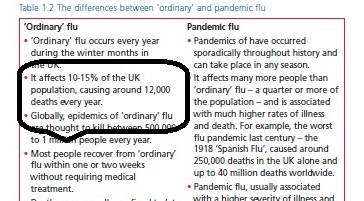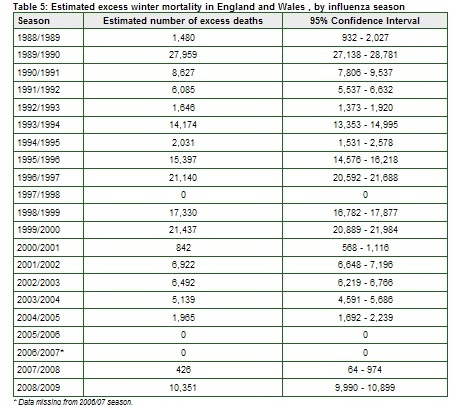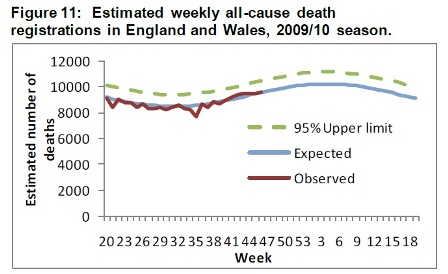Flu deaths: a triumph of statistics, not virology
Dame Deirdre Hine’s report on swine flu, published last Friday, acquits all involved of blame for spending £1.2 billion on a pandemic that turned out to be mild. The response, said Dame Deirdre, was “proportionate and effective” though there could have been more flexibility in planning and implementation.
Her report records there were 457 deaths from swine flu in the UK: 342 in England, 69 in Scotland, 28 in Wales and 18 in Northern Ireland. Most people, raised on the annual mantra from the Department of Health that regular seasonal flu kills 12,000 a year, would regard 452 as very mild indeed, especially after all the planning and dire warnings. As Professor Hugh Pennington put it rather wittily in The Scotsman: “The plan was good but the virus hadn’t read it.”
But first appearances can be deceptive. Estimating flu deaths is something of an arcane art, in which statistics plays as important a role as the virus itself. Very few deaths are ever proven to have been caused by flu alone, just a handful in most years. The rest are the result of examining “excess deaths” in the weeks of the year in which flu is widespread, and attributing a proportion of them to the complications of flu, such as pneumonia. This process is not always made clear: see, for example, an extract (below) from a 2005 document from the Chief Medical Officer, Sir Liam Donaldson entitled Explaining Pandemic Flu.

Anybody reading this would conclude that flu “causes” an average of 12,000 deaths a year in the UK. Sometimes even higher figures are quoted, up to 25,000 deaths a year. But in fact all we can say for certain is that flu causes a few tens of deaths a year, and is associated with a few thousand: in recent years, considerably fewer than 12,000.
In BMJ on 2 February 2010 Sir Liam himself published the figures for deaths caused by flu in England and Wales in the past four years. There were 39 such deaths in 2008, 31 in 2007, 17 in 2006 and 44 in 2005, he said. The total for the nine seasons 2000-2001 to 2008-09 (which he did not quote) was 358.
It could thus be argued that the swine flu pandemic killed as many people in England and Wales in a single year (342) as seasonal flu has in the past nine years (358). This comparison is invalid because surveillance was much more intense during the swine flu pandemic, and more deaths occurred in younger people, making them easier to identify. However, it is more accurate than comparing the UK figure of 457 with 12,000.
The 12,000 figure is a statistical artefact, created after the event by looking at all deaths, especially in older people, that appear in parallel with and slightly behind the surge in seasonal flu cases. These deaths may often be caused by respiratory symptoms, but can also include deaths from heart and circulatory diseases.
“When the number of all-cause death registrations rises above an ‘expected’ level in a given week, this excess is counted” Sir Liam explained. “The estimates for the last five years in England & Wales are: 1,965 (2004-05 winter season); 0 (2005-06); 0 (2006-07); 426 (2007-08) and 10,351 (2008-08).”
That’s an average of around 2,500 a year, rather than 12,000. If you search, you can find data equivalent to that used by Sir Liam, but going back much further. To save you searching, here’s a table from the Health Protection Agency that takes us back to 1988-89, the final four figures corresponding with the ones quoted by Sir Liam. Its source is here, page 12.

Some simple maths shows that the five-year average is 2,548 (as above) the ten-year average 5,357, and the 21-year average (covering the whole table) 8,068. It simply isn’t clear how this equates to the often-quoted figure of 12,000, especially as the HPA notes: “It should be noted that the excess is due to all causes so cannot be directly attributed to influenza”.
But in the annual effort to persuade people to be vaccinated, that is exactly what happens. The method has been criticised in the past as being as much PR as science, but is stoutly defended by epidemiologists, and it is undoubtedly true that flu infections in the elderly can trigger other health problems that lead to death. It suits those responsible for the immunisation campaigns for the numbers to be high, but if infections other than flu are contributing to some of these deaths, then the flu vaccine can do nothing to prevent them.
Studies of the effectiveness of the vaccine are contradictory, with at least one suggesting that the apparent benefit of the vaccine in preventing deaths in the elderly is due to fitter older people being more likely to be vaccinated. (1) The team involved, from various institutions in Seattle, found that in 72,527 people over 65 followed over an eight-year period, the risk of dying before the flu season was much lower in those who were vaccinated than in those who were not. They were simply healthier people.
What are the implications for swine flu? Unlike seasonal flu, it peaked in the UK in June/July 2009 and in October/November 2009, well before the normal flu season. There is no convenient peak in winter deaths to trawl for evidence of secondary effects. Swine flu also tended to spare the over-65s, who possessed some immunity to it through earlier exposure and who provide the bulk of the deaths attributed to flu in a normal season.
In England and Wales, there does not appear to have been any detectable increase in all-cause mortality during the two phases of the epidemic. The graphic below is from the HPA’s Weekly National Influenza Report for 3 December 2009. It does not show deaths deviating much from the expected levels. As Sir Liam put it in his BMJ article: “Had we relied solely on this measure, we would not have been aware of any deaths due to H1N1 influenza so far”.

Surveillance in Europe has tended to confirm this, with no major excess of deaths reported. One study of eight European countries did suggest an excess in children aged 5-14, but the numbers were small – 77 excess deaths. In the US, the Centers for Disease Control puts excess deaths at 12,000, while another American study produced the wide range 7,500 to 44,100 (2). Because of the age-structure of those affected, the years of life lost to swine flu were higher than simple death rates indicate, falling somewhere between a normal year and the 1968 flu pandemic, this paper estimates.
As further data becomes available, these estimates will be refined. But they suggest that swine flu, even though it fell miles short of some of the figures bandied about during the pandemic (65,000 deaths was one worst-case scenario quoted in the UK) was not as mild as many now believe.
Among the lessons learned was the need for better seroprevalence data – tests to show how widespread the infection was. Without them, no sensible estimate could be made of the case-fatality ratio. (See, for example, Sheila Bird’s article on this website in August 2009.) But such data were not available until September 2009, after the first wave of the pandemic was over.
Dame Deirdre’s report has little to say about this, unless I’ve missed it. But she does say: “It would be beneficial for the four health ministers to commission further work in this area to provide standardised, high-level surveillance information across the UK to aid any future pandemic response. I am encouraged therefore by the news that the Department of Health has established a working group to review the data collection procedures instigated during the H1N1 (2009) influenza pandemic for the benefit of any future influenza pandemic.”
(Note: It’s extraordinarily hard to find Dame Deirdre’s report. It isn’t on the Health Department or the Cabinet Office website. It doesn’t appear to be on the website of the COI, which distributed it and calls itself “the Government's centre of excellence for marketing and communications”. I had to ask the press office at the COI for a copy, which they kindly provided. Haven’t these people heard of the internet? For similarly frustrated would-be readers, I attach a PDF, so at least you can read it here.)
References
1. Evidence of bias in estimates of influenza vaccine effectiveness in seniors, by Lisa A Jackson, Michael L Jackson, Jennifer C Nelson, Mathleen M Neuzil and Noel S Weiss, International Journal of Epidemiology 2006; 35; 337-344
2. Preliminary estimates of mortality and years of life lost associated with the 2009 A/H1N1 pandemic in the US and comparison with past influenza seasons, Viboud C, Miller M, Olson D, Osterholm M and Simonsen L, PLoS Curr. Influenza, RRN1153 (2010)




Ashley Ford (not verified) wrote,
Tue, 06/07/2010 - 23:00
Thank you for making the pdf available. I searched without finding it.
It does seem very surprising that the only mention of statistics is in section 4.40
and no mention of the letter from the president of the RSS
Roger Eldridge (not verified) wrote,
Wed, 07/07/2010 - 12:59
Sorry can you show me where I can download the Report on Swine Flu, can't see it
Roger Eldridge (not verified) wrote,
Wed, 07/07/2010 - 13:00
Just seen it now thanks and God bless, Roger